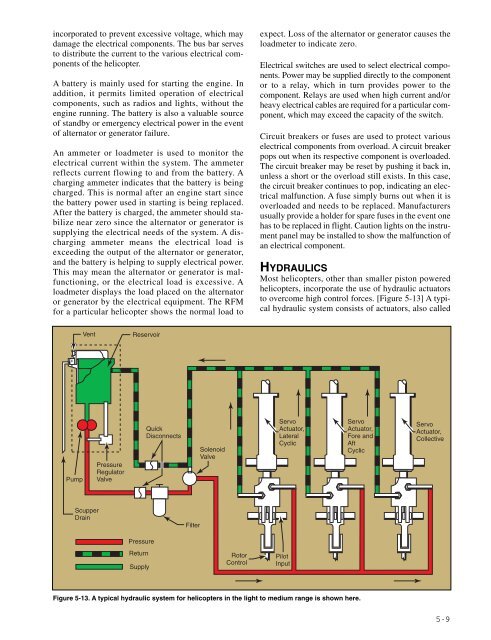Rotorcraft Flying Handbook, FAA-H-8083-21
Rotorcraft Flying Handbook, FAA-H-8083-21
Rotorcraft Flying Handbook, FAA-H-8083-21
You also want an ePaper? Increase the reach of your titles
YUMPU automatically turns print PDFs into web optimized ePapers that Google loves.
incorporated to prevent excessive voltage, which may<br />
damage the electrical components. The bus bar serves<br />
to distribute the current to the various electrical components<br />
of the helicopter.<br />
A battery is mainly used for starting the engine. In<br />
addition, it permits limited operation of electrical<br />
components, such as radios and lights, without the<br />
engine running. The battery is also a valuable source<br />
of standby or emergency electrical power in the event<br />
of alternator or generator failure.<br />
An ammeter or loadmeter is used to monitor the<br />
electrical current within the system. The ammeter<br />
reflects current flowing to and from the battery. A<br />
charging ammeter indicates that the battery is being<br />
charged. This is normal after an engine start since<br />
the battery power used in starting is being replaced.<br />
After the battery is charged, the ammeter should stabilize<br />
near zero since the alternator or generator is<br />
supplying the electrical needs of the system. A discharging<br />
ammeter means the electrical load is<br />
exceeding the output of the alternator or generator,<br />
and the battery is helping to supply electrical power.<br />
This may mean the alternator or generator is malfunctioning,<br />
or the electrical load is excessive. A<br />
loadmeter displays the load placed on the alternator<br />
or generator by the electrical equipment. The RFM<br />
for a particular helicopter shows the normal load to<br />
expect. Loss of the alternator or generator causes the<br />
loadmeter to indicate zero.<br />
Electrical switches are used to select electrical components.<br />
Power may be supplied directly to the component<br />
or to a relay, which in turn provides power to the<br />
component. Relays are used when high current and/or<br />
heavy electrical cables are required for a particular component,<br />
which may exceed the capacity of the switch.<br />
Circuit breakers or fuses are used to protect various<br />
electrical components from overload. A circuit breaker<br />
pops out when its respective component is overloaded.<br />
The circuit breaker may be reset by pushing it back in,<br />
unless a short or the overload still exists. In this case,<br />
the circuit breaker continues to pop, indicating an electrical<br />
malfunction. A fuse simply burns out when it is<br />
overloaded and needs to be replaced. Manufacturers<br />
usually provide a holder for spare fuses in the event one<br />
has to be replaced in flight. Caution lights on the instrument<br />
panel may be installed to show the malfunction of<br />
an electrical component.<br />
HYDRAULICS<br />
Most helicopters, other than smaller piston powered<br />
helicopters, incorporate the use of hydraulic actuators<br />
to overcome high control forces. [Figure 5-13] A typical<br />
hydraulic system consists of actuators, also called<br />
Vent<br />
Reservoir<br />
Pump<br />
Pressure<br />
Regulator<br />
Valve<br />
Quick<br />
Disconnects<br />
Solenoid<br />
Valve<br />
Servo<br />
Actuator,<br />
Lateral<br />
Cyclic<br />
Servo<br />
Actuator,<br />
Fore and<br />
Aft<br />
Cyclic<br />
Servo<br />
Actuator,<br />
Collective<br />
Scupper<br />
Drain<br />
Filter<br />
Pressure<br />
Return<br />
Supply<br />
Rotor<br />
Control<br />
Pilot<br />
Input<br />
Figure 5-13. A typical hydraulic system for helicopters in the light to medium range is shown here.<br />
5-9

















